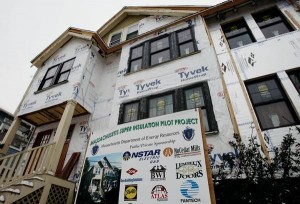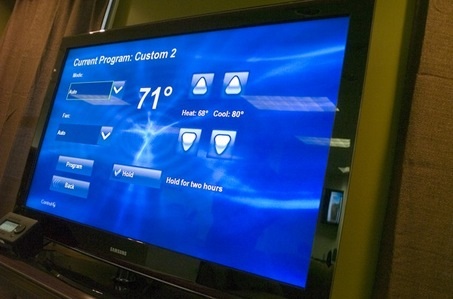That’s the headline at Seacoast Online. But looking at the photo below, it seems you’ll only be perform the audit if you have your own infrared camera and blower door.

Energy audit in progress

That’s the headline at Seacoast Online. But looking at the photo below, it seems you’ll only be perform the audit if you have your own infrared camera and blower door.

Energy audit in progress
From our ‘talk the talk, walk the walk’ department, comes this item on the Green Inaugural Ball, held last night at the Smithsonian Institute-located just off the National Mall.
The Green Ball, of course, was billed as carbon neutral. The emissions generated from the electricity used at the event were offset by buying emissions-reduction credits from Native Energy, which supports Native American, farmer-owned, community-based renewable energy projects. It was a lot of electricity, judging from the megawatt sound system. “It’s a bit loud,” said Paula DiPerna, executive vice-president for the Chicago Climate Exchange, who regretted not bringing earplugs.
Possibly the only ball where the star wasn’t President Obama, it was this guy.
It started with a small water stain on the dining room ceiling that nagged at Alex Cheimets.
By the time he finished fixing the leak, his house was clad in insulation so thick he needed special 10 inch screws just to attach it to the siding. And the MA State Government had signed on a sponsor for his $100,000 home improvement project.

The Super Insulated House in Arlington, MA has attracted an impressive group of sponsors.
Part of the state’s payoff will come after the work is done. Sensors will measure humidity and help track heat loss. A blower test with a giant fan will see just how tight the home is sealed. An oil tank sensor will track oil use at different indoor and outdoor temperatures.
Consumers are becoming more green-conscious as the global economic crisis worsens, according to a report published today by The Boston Consulting Group (BCG).
These findings — published in “Capturing the Green Advantage for Consumer Companies” — reflect consumers’ growing alarm about the state of the environment and suggest they have not abandoned their principles as their financial woes have increased.
Of course, that doesn’t mean companies can charge whatever they like for organic or green products either…
Sony has a new line of Liquid Crystal Display (LCD) TVs that use less power when they are switched on. And switch themselves off when they sense no-one is watching.
The Bravia V5 line sets, which will go on sale in most major markets worldwide, are equipped with a small sensor underneath the display that keeps watch of the room to ensure someone is there. If all the viewers leave the room it cuts power to the LCD (liquid crystal display), only to switch it back on when someone returns.
All Sony Bravia V5 models exceed the new EnergyStar 3.0 specification.
But what if there was a government incentive to make energy improvements that would make a significant dent in your mortgage payment along with that less-detectible cut in your utility bill? Would you then make those improvements? What if the government bought down your mortgage at a proportion relative to the level of energy improvements made on your house? Would that make you get up on a ladder and caulk around a window,or buy a new air conditioning system? You’d certainly be more likely to.
Sounds like an economic stimulus plan (of sorts), one that is the central theme of the Architecture 2030 Challenge Stimulus Plan. From their press release:
The Challenge Stimulus Plan is sponsored by Architecture 2030, a nonprofit research organization supported by organizations such as the US Conference of Mayors (USCM), Department of Energy (DOE), Environmental Protection Agency (EPA), US Green Building Council (USGBC), American Institute of Architects (AIA), American Society of Heating, Refrigeration and Air-Conditioning Engineers (ASHRAE).

The Citizen Patriot newspaper in Jackson, Michigan ran a story yesterday about the new ‘smart’ meters Consumers Energy customers will start seeing in their homes. It’s actually a visual display panel that will allow their customers to see-and control–energy usage in their homes.
When prices peak, special thermostats could automatically dial down or shut off air conditioning. Lights, appliances and electronics could also be controlled through display panels or connections to home computers that show energy usage or notify customers of high energy costs.
Consumers Energy will be installing units in 6,000 homes over the next year. Sounds like a great program, and judging by the comments this article has attracted, Consumers Energy needs all the good PR they can get. Warm Home Cool Planet is happy to help!
The drop in energy prices-at the pump and in the home-we saw in the last quarter of 2008 will likely stay with us through 2009 according to the US Department of Energy. Add that to the shaky economic outlook and that means people will be less likely to undertake home repairs and improvements for the next 18 months.
Builders and handymen will be looking for work-and available. So there’s never been a better time to plan an energy efficient makeover for your house. Get it done before oil and gas prices start to rise in 2010.
When you think of how long your more visible household appliances have had Energy Star Labels this seems a long time coming.
The New Year brings with it tidings of joy and energy-efficient hot water, as Energy Star-qualified residential water heaters are now available. High-efficiency versions of the conventional tank storage water heater can earn the label, as well as solar water heaters, heat pump water heaters, and whole-house tankless models.
Get the whole scoop from the US Department of Energy.
Wireless Electricity (or the concept) has been around since 1890 when Nicholas Tesla built a 200 ft, 100,000 watt tower that sent 130 ft bolts into the sky and turned the grass blue. Now, thanks to MIT Asst. Professor and 2008 MacArthur Genius Grant Winner, Marin Soljacic, wireless electricity is close to reality. And it’s greener than you think:
But wireless technology is not only neater (say good-bye to the power-strip Medusa under your office desk), it’s cleaner. The EPA says Americans purchase a total of 3 billion disposable dry-cell batteries every year (part of a worldwide market of about 15 billion) and then throw 2.8 billion of them into landfills. Wireless systems are designed for rechargeable batteries that can be reused hundreds of times before they become trash. Continue reading